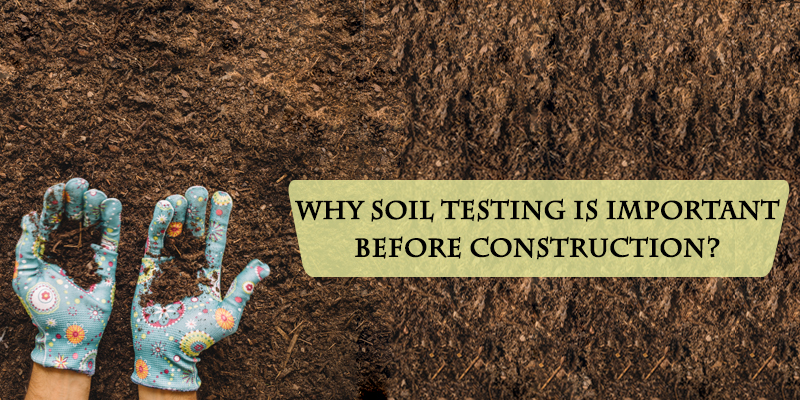Why Soil Testing is important before Construction?
It is important to check the quality of soil before you build your dream home. The ground where you are planning to make your dream home it is important to check the soil quality of it before your construction work begins.
Soil testing is primarily done to test the bearing capacity. The chemical and physical composition of the soil is checked during this process. The soil must have the ability to withstand the weight of the building. Quality of soil not only determines the bearing capacity but it ensures to determine the structure stabilization. Quality of Soil depends upon various factors such as weather, climate change and for the past years the land was deployed for what purpose and what was there previously.
The length and depth of the pillar determined during the foundation depending upon the quality of soil. The water level of the soil only can be determined from soil testing. Based on the soil testing reports quality of material can be decided. For example if due to moisture the area is prone to corrosion then it is important to choose only corrosion resistant TMT Bars for the construction.
Soil test is very important step of construction before it begins. If the soil testing is not done then the building will be exposed to unknown dangers and might the end result could be fatal.
Different types of Soil Testing for Construction
Gravity Test
Gravity of the soil is the ratio of unit weight of soil solids to that of the water.
There are quite a few methods by which the gravity test can be done but Density Bottle Method and Pycnometer Method is the most simple and common ones to get the accurate result. In Pycnometer method, Vertex specific gravity bottle is known as pycnometer it is weighed in 4 different cases that is
- Empty weight (M1)
- Empty + dry soil (M2)
- Empty + water + dry soil (M3)
- Pycnometer filled with water (M4)
At room temperature. From these 4 masses specific gravity is determined by below formula.
G = (M2 – M1) / (M2 – M1) – (M3 – M4)
Moisture Test
In this method samples are collected from the site and weighed before it is put on the oven before drying. After taking the weight it is out on the oven and dried at 110o + 5oC.
After 24 hours it is taken out from the oven and again weighed. The difference between two weights is noted and the water or moisture content is determined from the difference in weight.
Atterberg Limits Test
Atterberg limits test on soil is performed at 3 levels. The component for testing is done with fine grained soil and if any critical component from water is present then it can be determined with it. The three limits that are evaluated:
- Liquid Limit
- Plastic Limit
- Shrinkage Limit
* Liquid Limit Test
The device that is used for this test is called Casagrande’s liquid limit device. This device consist a cup with moving up and down mechanism. The cup is moved up and down with the help of handle the groove becomes closed at some point.
Once the water content of soil is determined procedure of if needs to be repeated 3 times post that a graph to be drawn between log N and water content of soil. Water content corresponding to N=25 is the liquid limit of soil.
* Plastic Limit Test
In this test small balls needs to be created by adding some water into it. After resting it for sometime the small balls are to put into glass plate and rolled it to 3mm diameter.
Until the threads break when it rolled into diameter that is less than 3mm water content is to be reduced. It is to determine the water content of resultant soil which value is nothing but plastic limit.
* Shrinkage Limit Test
The existing water in the soil is just sufficient to fill the voids. The below formula is used to be done for shrinkage test on soil.
Ws = (M2 – M1)n – (V1 – V2) Pw / M2
M1 = initial mass
V1= initial volume
M2= dry mass
V2= volume after drying
Pw = density of water
Dry Density Test
Dry Density Test in Soil is performed at 2 Levels
* Core Cutter Method
With the help of cylindrical core cutter of standard dimension is used to cut the soil from ground and the sample is tested by weighing it. Water content from that sample is determined and the dry density is calculated from the below relation.
P = (M/V) / 1+w
* Sand Replacement Method
In this method by excavation a hole is created and the soil dry density to be measured with it. The hole is filled with uniform sand of known dry density. Dividing the mass of sand poured into the hole with dry density of sand gives the volume of hole.
Proctor’s Compaction Test
Compaction in soil is one of the most important elements that are to find during Proctor’s Compaction Test on soil. It is to do the densification by reducing the air voids in soil. The level of Compaction is estimated as far as dry thickness of soil.

